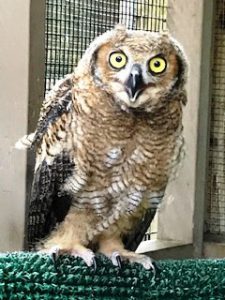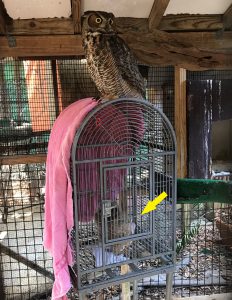Environmental Science is an important 4-H project area. Environmental science includes marine ecology, forestry, archery, survival skills, birds, insects, wildlife, fishing, and other outdoor topics. The aim of the environmental science program is for youth to be more aware of environmental needs and change their behavior related to environmental science. In St. Johns County, the Environmental Explorers 4-H Club was formed to increase the 4-H’ers positive attitudes towards environmental science and engage in conservation-focused behaviors.
Saving an Owlet
Last March, a member of the Environmental Explorers 4-H club, Nathan, discovered a great horned owlet in his backyard.
The great horned owl is native to the Americas and extremely adaptable. When great horned owls are born, they are pink with downy feathers and closed eyes. Great horned owlets open their eyes at approximately 6-9 days. They leave the nest to explore on a branch at five weeks. Owlets are unable to fly with their downy feathers. Nathan took the fluffy owlet in, fed it raw chicken, and contacted me to find out what to do next. I told his mother to contact H.A.W.K.E. (hawkewildlife.org), a federal and state approved rehabilitation center in Elkton, FL, and gave her the number. Nathan and his mom took the owlet directly to H.A.W.K.E. where he could be helped.
Not Out of the Woods Yet

The owlet was very thin. Melanie Cain-Stage, H.A.W.K.E. Director, said they felt his keel where there should have been muscle on both sides. Flying birds have a keel—a ridge on the sternum, or breastbone, which is a main site of attachment for flight muscles. The owlet had other problems. She said they could not weigh him because he was in poor health and unable to endure the stress of weight measurement. The level of stress was so high, excessive handling could have led to death.
From Owlet to Owl
When the owlet arrived at HAWKE, he was just getting out of the nest and did not have of all his flight feathers. Melanie said it appeared the owlet may have had a head injury as he wouldn’t eat by himself. This resulted in the staff feeding him pieces of whole mice, mimicking what he would eat in the wild. After about a week of feeding him with thongs, he was picking up pieces and eating on his own. During this phase of development, he ate three times a day, a total of 30 mice. The owlet swallowed the medium sized mice whole.

Melanie knew that a member of the 4-H club rescued the owlet. HAWKE’s director wanted to keep the 4-H club aware of the owl’s development to encourage environmental stewardship. Because the owl had been so weak with an uncertain future, she waited for the owl to get stronger before involving the club. Finally, the owl began to fledge and she offered the club the opportunity to name the owl. The group took a vote and chose Bucky. Melanie forwarded photos for the 4-H’ers see Bucky’s progress over time.

Role Model
Juvenile owls begin to fly at 9-10 weeks but continue to be fed by their parents for several months. Bucky was past imprinting age. Therefore, he shared an enclosure with an adult great horned owl, who acted as a role model for him. He learned to catch live mice in a large tub. Later, he and the adult owl hunted for themselves. As he matured and spent time with the adult owl, he settled into being wild and did not imprint on humans. Bucky acted mean but Melanie said he was just being an owl. Finally, he was behaving like he was ready to be released. It was getting close to time for Bucky to go out on his own.
Check out the blog Bucky the Owl Part 2: The Release to see what happens next.
 0
0
